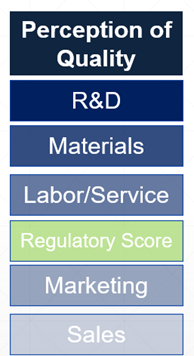It seems like a simple question until you try to answer it.
Last week, a client and I were working on the design for a custom business simulation to teach Business Acumen skills to the top 150 leaders and one of the issues she was struggling with was how to share with the executive leadership team the way we are going to train the participants on the topic of quality.
This blog is an interesting summary of the findings and hopefully is of interest to you as you continue to build your business acumen capabilities.
Quality vs. The Perception of Quality
One of the first things I shared is that we must start the definition process by collectively establishing an understanding that there is a significant difference between intrinsic and benchmarked quality and the perception of quality. In its purest technical form, an organization can measure quality to some sort of defined benchmark. But that benchmark is going to be arbitrary and at best based on a combination of science and objectivity.
Let’s look at pain relief medication as a simple example. Jane loves yoga and decided to go to an extra hard class. She is tired and sore and reaches for her favorite over-the-counter pain reliever. The brand she buys is a top seller and has been so for more than 50 years. To the company making the pain reliever, they define quality as manufacturing and distributing a medication that is made from raw materials that will solve the unmet medical needs of patients dealing with pain. There are benchmarks for the amount and combination of materials used in manufacturing, and if the company is compliant with the formula, they have a “score” of 100; the place where the product will offer the minimally viable amount of relief. Higher quality raw materials and optimized manufacturing practices could bring the quality metric to a 102 or a 103 and the biggest questions will revolve around the cost required to get there.
There are those, such as me, who think an absolute scientific method of defining quality is superfluous and that the real metric that should be measured is the perception of quality. The perception of quality is how your customers see the brand and sometimes the company from a quality perspective. In our business simulations, we provide an alternative way to understand and drive the perception of quality through operational decision-making. Here the perception of quality is a function of:
that the real metric that should be measured is the perception of quality. The perception of quality is how your customers see the brand and sometimes the company from a quality perspective. In our business simulations, we provide an alternative way to understand and drive the perception of quality through operational decision-making. Here the perception of quality is a function of:
- R&D - The amount of investments made (threshold and peer group benchmarking)
- Materials – Typically lower high quality, higher quality, and highest quality
- Labor / Service – The experience of the R&D team, competence of team
- Regulatory score – Based on product, message, and investment in the process
- Marketing – Investments and message
- Sales – Competence and size of the sales team (based on training and support)
Internal Quality (Compliance) vs. External Quality
Many of the clients we work with have strong and robust Quality Departments. In most situations, the Quality Department in an organization has the primary goal to monitor and manage the quality of the organization. There could be a Quality Assurance (QA) group that is focused on ensuring that the delivered service or product meets the internally set requirements. There is often a Quality Control (QC) organization that focuses on the execution of processes to the internally set procedures and requirements. What is common in this view is what is called “Compliance Quality.” The quality programs focus on compliance with requirements and procedures that are created internally with a belief that when executed, the outcome will usually meet the basic customer need. High Quality is the perfect execution of the procedures and meeting all outcome requirements.
When we talk of quality in the view of the customer, the definitions become softer. Different customers may deem the same product or service quite differently. The difference is generally due to the customer expectations being different. The expectation of delivery-excellence changes with the cost of the product or service too. High performance exceeds customer expectations. We call this customer expectation “Performance Quality.”
Why is it Important?
From a business acumen capabilities perspective, product quality is important because it affects the success of the company and helps establish its reputation in customer markets. When companies can create high-quality products that continue to meet or exceed customer demands, it can lead to lower production costs, higher increases in revenue, and higher profitability.
Product quality also matters to the customers who depend on a company's attention to detail and customer demand. Companies create products to fill a need in the market, and consumers expect products to meet that need as the company markets them. They want products that help them establish a connection with a brand so they know they can rely on the company's offerings. Quality products provide customers with safe, effective ways to solve their problems.
In summary, this is indeed an important conversation with difficult answers. No matter what your overall strategy is, you need to have people with the skills to determine and drive the perception of quality that supports your value proposition to customers.




